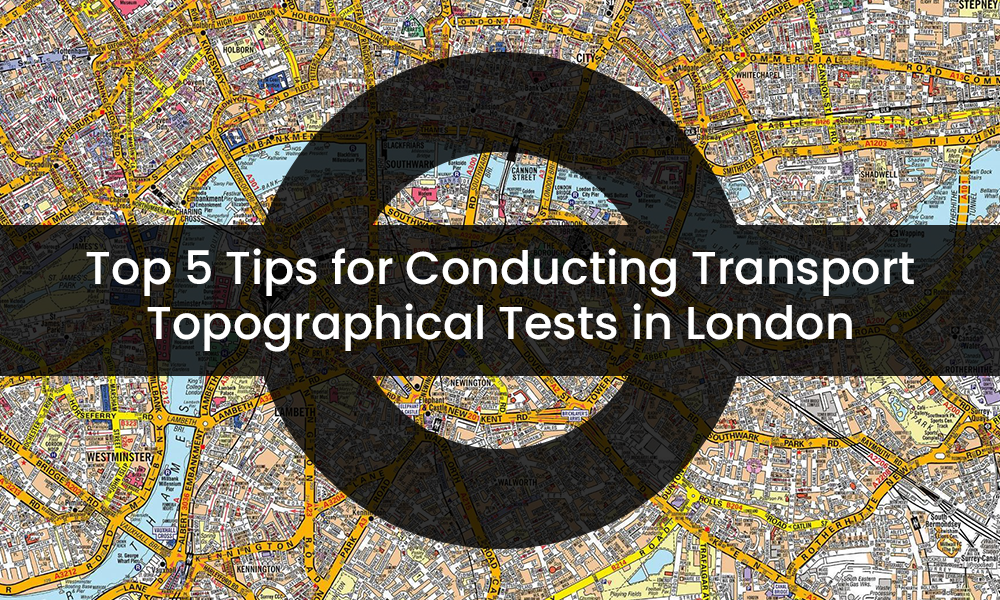Subtotal £0.00
Regarding transport infrastructure planning, topographical tests are essential for ensuring the road systems are safe, efficient, and well-designed. Particularly in London, where traffic is dense and the city’s transport network is complex, topographical surveys help gather accurate data for new construction and development projects.
Whether you are planning a new road, bridge, or private hire vehicle certification, understanding how to conduct these tests properly is crucial. In this blog post, we’ll discuss the top 5 tips for conducting transport topographical tests in London, covering everything from TFL topographical test to the PCO test and the overall topographical assessment process.
What is a Topographical Test?
A topographical test is a survey designed to map the physical features of a location. It provides valuable information on the terrain, natural features, existing structures, and infrastructure that may influence urban development or construction. These tests are vital for ensuring that any new transport or infrastructure projects are built with an understanding of the landscape and existing conditions.
In London, topographical tests help transport engineers and urban planners understand how proposed projects will fit within the city’s complex layout. Whether for road development, a new railway, or urban planning, the test provides essential data that influences design decisions and project feasibility.
TFL Topographical Test: What Makes it Unique?
The TFL topographical test is specific to projects that fall under the jurisdiction of Transport for London. TFL regulates the city’s public transport network, including buses, cycling lanes, pedestrian routes, and roads. A topographical test assesses how a proposed transport system interacts with existing infrastructure and ensures that the project complies with TFL’s standards.
How Many Questions Are There in the Topographical Test?
When it comes to PCO tests for private hire vehicles, these tests assess a driver’s ability to navigate London’s busy streets safely. The PCO test includes questions related to road knowledge, landmark identification, and traffic regulations. The number of questions typically ranges from 25 to 40, depending on the specific version of the test.
Key Areas Covered in the PCO Test
- Major roads and highways in London
- Landmark identification: Recognizing important locations and streets
- Traffic regulations: Understanding the rules of the road
- Route planning: Identifying the fastest and safest routes
- Congestion zones: Understanding the impact of congestion charges and tolls
These questions are designed to test a driver’s ability to safely navigate the city and ensure that private hire vehicles are capable of complying with local traffic rules. A solid understanding of these concepts is crucial for passing the PCO test.
Top 5 Tips for Conducting Transport Topographical Test in London
1. Understand the Specific Requirements of TFL
When conducting a TFL topographical test, it’s important to familiarize yourself with the specific requirements outlined by Transport for London. TFL has stringent guidelines for any development or construction that impacts their transportation network. Understanding these requirements will help you ensure that your project complies with all necessary regulations.
Some of the key considerations include:
- Traffic flow patterns: How traffic moves through key areas and whether it will be impacted by the proposed project.
- Integration with existing infrastructure: Ensuring your design complements the current public transport network.
- Safety standards: Meeting TFL’s safety requirements for road design, traffic control, and pedestrian access.
By understanding these requirements, you ensure that your topographical test provides valuable and compliant data for your project.
2. Incorporate Advanced Technology for Better Precision
In today’s world, technology plays a huge role in improving the accuracy and efficiency of topographical tests. Using modern tools such as LiDAR, drones, and 3D mapping software will allow you to gather detailed, accurate data that traditional methods might miss.
Benefits of incorporating advanced technology include:
- High accuracy: Drones and LiDAR can capture fine details such as elevation changes and obstacles.
- Faster results: Technology enables quicker data gathering, reducing project timelines.
- 3D visualizations: These tools help create realistic models of the terrain, making it easier to understand how a project will impact the landscape.
By utilizing these technologies, you can improve the quality of your topographical assessment, which will ultimately result in better decision-making for the development.
3. Ensure Compliance with Local Regulations
London’s transport infrastructure is subject to numerous regulations to ensure the safety and functionality of roads, railways, and private hire vehicles. When conducting a topographical test PCO for private hire vehicles, you must ensure that the vehicle and driver meet the standards required for the PCO test.
Key regulations to keep in mind include:
- Vehicle standards: The vehicle must meet certain safety requirements such as emissions and accessibility.
- Driver knowledge: Ensure that the driver has a comprehensive understanding of London’s streets and traffic regulations.
- Submission of test data: Be sure that the test results are submitted according to the correct format and within the time frame set by local authorities.
Compliance is key to avoiding fines and ensuring that the project proceeds smoothly.
4. Prioritize Traffic Flow and Safety
The primary goal of a topographical test in transport planning is to assess how the project will affect traffic flow and overall safety. In London, a city with dense traffic and numerous congestion points, this is a critical aspect of any development.
To improve traffic flow and safety:
- Identify potential congestion points: Analyze how the development might affect traffic congestion and identify measures to address this.
- Safety measures: Evaluate where safety improvements are needed, such as adding crosswalks, improving signage, or installing traffic lights.
- Environmental factors: Consider the environmental impact, such as noise pollution and the effect on local ecosystems.
Taking these factors into account will help reduce traffic disruptions and enhance the safety of your proposed infrastructure project.
5. Work with Experienced Surveyors and Engineers
One of the most important aspects of conducting a topographical test in London is partnering with experienced professionals. Experienced surveyors and transport engineers have the skills and knowledge to handle the complexities of London’s infrastructure. They will ensure that the data collected is accurate and that all relevant regulations are followed.
Benefits of working with experts:
- Accurate data: Professionals ensure that the topographical survey is thorough and precise.
- Regulatory knowledge: They are familiar with local regulations and help ensure compliance.
- Project efficiency: By working with experts, the survey process becomes faster and more effective, saving you time and money.
Engaging the right team for your topographical assessment will ensure that the test results are reliable and that your project moves forward seamlessly.
Why Choose pcogo.co.uk for Your Topographical Tests?
At pcogo.co.uk, we understand the critical role that accurate topographical assessments play in the success of minicabs and taxi in London. Our team of experienced surveyors and transport engineers is dedicated to providing high-quality testing services that meet all local regulations and project requirements.
With years of experience in the field, we utilize the latest technology, including LiDAR, drones, and 3D mapping software, to provide precise and efficient topographical tests. Whether you’re preparing for a TFL topographical test, a PCO test, or any other transport-related project, our experts ensure your survey is accurate, compliant, and valuable.
Choosing pcogo.co.uk means partnering with professionals who understand the complexities of London’s infrastructure. Let us help you navigate the topographical testing process with ease and efficiency, ensuring your transport projects are set for success.
FAQs
1. Is the TfL topographical test hard?
It can be tough without preparation, especially for those unfamiliar with London. With proper study and practice, most candidates pass successfully.
2. What are the tests for TfL?
TfL requires a topographical test, English language test, and enhanced DBS check. These ensure drivers meet safety, communication, and navigation standards.
3. What is the pass mark for the TfL topographical test?
The current pass mark is 60%. You must correctly answer enough questions in each section to pass overall.
4. What is the pass rate for a Topographical Test?
The average pass rate is around 50–60%. Candidates who prepare with mock tests and map skills have higher success..
5. What happens if you fail the TfL English test?
You will not be issued a PCO license. You must retake and pass the test before continuing the application process.

